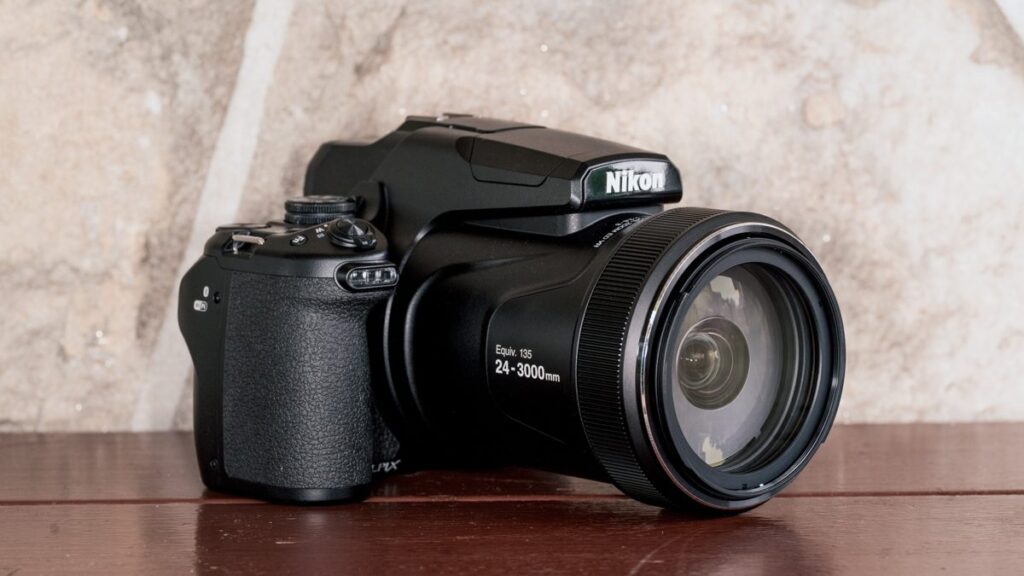
The Nikon Coolpix P1100, priced at $1,099.95, is the successor to the P1000, continuing Nikon’s ambitious quest to maximize zoom power in a bridge camera. Despite minor updates like a USB-C charging port and additional scene modes, the P1100 retains the same slow performance and challenging autofocus as its predecessor, making it less ideal for wildlife photography. For those seeking a more balanced option, the Canon PowerShot SX70 HS, with its 1,365mm zoom lens, offers a more practical alternative at $749.99.
Design: Unmatched Zoom Power
The P1100’s standout feature is its colossal 125x zoom lens, equivalent to a 24-3,000mm lens on a full-frame camera. This extraordinary zoom capability is made possible by the camera’s smaller image sensor, resulting in a lens that is both impressive and cumbersome. The camera’s body is necessarily large to support the lens, measuring 4.7 by 5.8 by 7.1 inches when powered down and extending to 11.5 inches at full zoom. Weighing 3.1 pounds, the P1100 is the largest in its class, a direct consequence of its powerful lens.
While the 3,000mm zoom can capture distant subjects like the moon or a bluebird from 100 feet away, it often removes context from the scene. For many situations, a less extreme focal length is preferable. Nikon’s Coolpix P950, with its 83x (24-2,000mm) zoom, offers a more balanced option, being smaller, lighter, and less expensive at $799.95. The Canon SX70 HS, with a 21mm starting angle and 1,365mm zoom, is the most compact and affordable of the three.
Controls and Interface: Good Ergonomics, Apart From Clumsy Autofocus
The P1100’s design borrows heavily from Nikon’s full-frame Z5II, yet its user interface is less configurable. The camera features numerous controls, including two zoom rockers and a framing assist button. However, moving the focus point is cumbersome, requiring multiple button presses, and the autofocus lacks smart subject recognition for animals. This can be problematic when photographing wildlife, as the camera often focuses on the nearest object rather than the intended subject.
The P1100’s Bird Watching mode simplifies focus by using a small central point but disables Raw image capture. The lack of a touch screen further complicates focus adjustments, as many modern cameras use touch screens to set focus points easily.
Viewfinder and Display: Wait, That’s Not a Touch Screen?
The P1100’s electronic viewfinder (EVF) is commendable for its size and clarity, though not as sharp as full-frame counterparts. However, the rear LCD is a basic 3.0-inch, 921k-dot display without touch capabilities, limiting its functionality. A touch screen would have been beneficial for setting focus points, especially when using the EVF.
Power and Connectivity: Solid Battery Life, Plus External Flash Support
The P1100’s EN-EL20a battery supports 260 photos per charge, comparable to its peers. Charging via USB-C allows for convenient recharging from power banks. Connectivity options include micro HDMI, a 3.5mm microphone input, and a UHS-I SDXC memory card slot. The camera also supports wireless transfer and remote control through the Nikon SnapBridge app.
Autofocus: Struggles to Capture Subjects in Motion
The P1100’s autofocus system is basic, with face detection limited to humans. Its burst capture capabilities are sufficient for static subjects but struggle with moving targets. The camera offers various continuous drive modes, but its 7fps burst rate is limited to one second of action. In contrast, the Canon SX70 HS provides a faster 10fps rate with a deeper buffer, making it more suitable for action scenes.
Overall, the P1100’s autofocus and burst capture are underwhelming, especially given its impressive lens. While it can capture a wide range of subjects, its performance is hindered by slow autofocus.
Image and Video Quality: Best Results in Bright Light
Utilizing the same lens, sensor, and processor as the P1000, the P1100 delivers clean 16MP images at lower ISOs but loses detail at higher settings. Raw capture is recommended for better noise reduction at higher ISOs. The lens provides excellent clarity up to around 800mm, with diffraction affecting quality beyond f/5.6.
The P1100’s video capabilities include 4K30 and 1080p60 recording, but a tripod is necessary for stability at longer focal lengths. The camera’s built-in mic is sensitive to ambient noise, so an external mic is advisable for outdoor recording.
In conclusion, while the Nikon Coolpix P1100 offers unmatched zoom power, its performance is limited by slow autofocus and a lack of modern features like a touch screen. Wildlife photographers may find better options in the Canon PowerShot SX70 HS or other models with faster autofocus systems.







